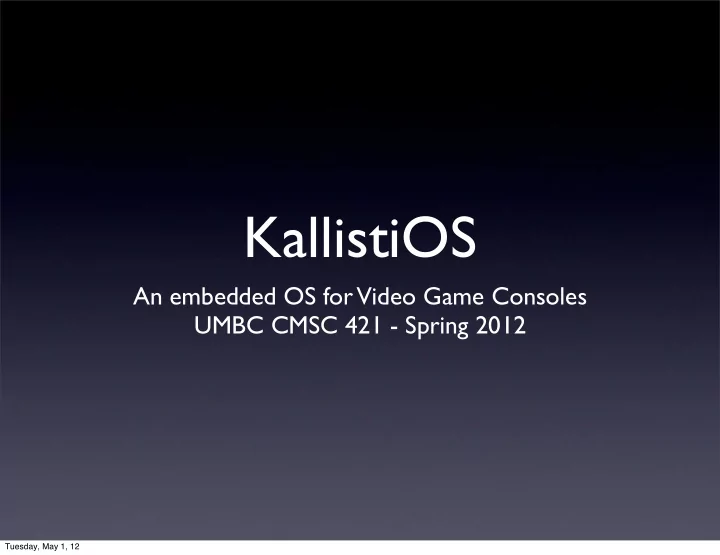

KallistiOS An embedded OS for Video Game Consoles UMBC CMSC 421 - Spring 2012 Tuesday, May 1, 12
Embedded Systems • Computers (and OSes, of course) are everywhere! • Low-power, low-memory devices make up a large proportion of the market • These embedded devices require careful programming and much smaller code than many OSes today provide Tuesday, May 1, 12
Embedded Systems • The video game consoles of yesteryear are very much like today’s embedded systems • They do not come with real Operating Systems installed on them -- they are included with/linked directly to the games • If that’s the case, then how are they an OS? Tuesday, May 1, 12
Embedded OSes • Many current examples of embedded OSes look a lot more like traditional OSes, as the devices themselves are much more powerful • iOS • Linux (Android) • Windows Phone/Windows RT Tuesday, May 1, 12
Embedded OSes • However, there are plenty of other embedded systems than just cell phones • On-board computers (ECUs and such) in cars • Medical equipment • Microcontroller-based systems Tuesday, May 1, 12
A Different Idea of an OS • These low-powered devices require a fundamentally different idea of an OS than the other examples of embedded OSes • Very little RAM, potentially no writable storage, a very specific set of devices to support, etc. • Many features of an OS are not required or are completely useless on these! Tuesday, May 1, 12
A retrospective... • As an example, lets take a closer look at the Sega Dreamcast • Released in 1999 (1998 in Japan) Tuesday, May 1, 12
System Specifications • 200 MHz Hitachi SuperH 4 processor • 16 MB of system RAM • PowerVR 2 GPU - 8 MB of Video RAM • GD-ROM media (read-only) • Various external peripherals (controllers, memory cards, camera, keyboard, mouse, network card) Tuesday, May 1, 12
What would its OS look like? Tuesday, May 1, 12
Enter KallistiOS • KallistiOS is an embedded OS for video game consoles, including the Dreamcast • Developed by the homebrew community without use of the official SDKs • Lacks many of the abstractions of todays mainstream OSes, but makes up for it in its ease-of-use for programming and its relative speed Tuesday, May 1, 12
What KOS is • A “pseudo-real-time OS” • Monolithic kernel with ability to load modules • Hardware manager (interrupts, DMA, MMU, etc) • Pseudo-POSIX layer (libc, pthreads, VFS) • Hardware abstraction layer Tuesday, May 1, 12
What KOS does not do • Full POSIX-compliance • Multi-tasking (multiple independent processes) • Memory protection Tuesday, May 1, 12
Well, how is that an OS? • Think back to what an OS has as its main tasks... • Resource allocation • Control program • Does KOS handle them? - Of course! Tuesday, May 1, 12
The KOS Kernel • Divided into several subsystems: • Pseudo-POSIX layer • Virtual Filesystem • Threads • Networking • Hardware Support Tuesday, May 1, 12
Programming with KOS • No user/kernel mode distinction (unless you want to provide it) • Direct hardware access (for the most part) • Several normal OS-like abstractions (libc, C++ iostreams, BSD sockets, partial OpenGL support) • User programs statically link the kernel Tuesday, May 1, 12
Recommend
More recommend